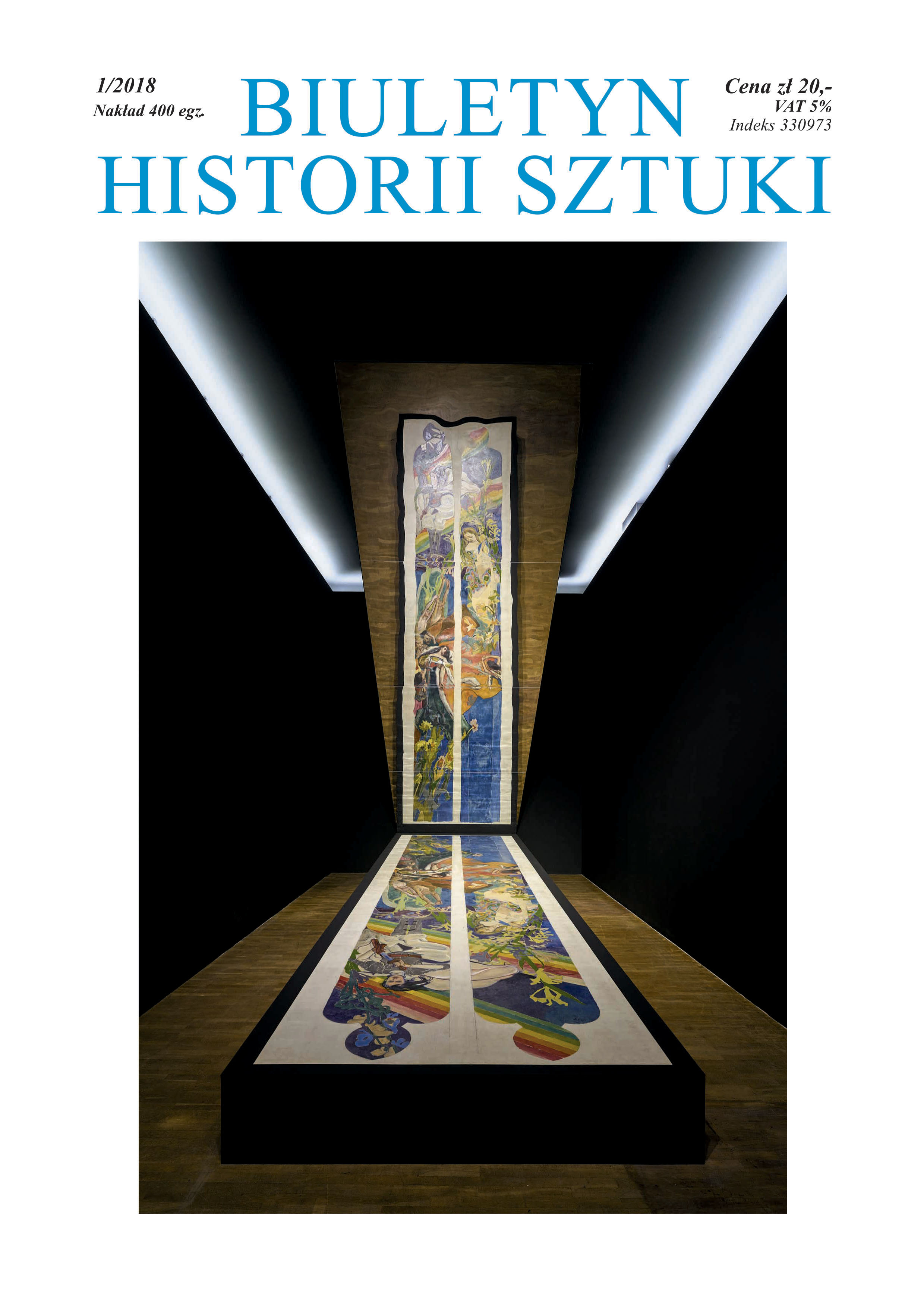
We kindly inform you that, as long as the subject affiliation of our 300.000+ articles is in progress, you might get unsufficient or no results on your third level or second level search. In this case, please broaden your search criteria.

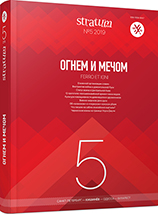
Despite relatively short period of Sasanian occupation of Egypt, there is much evidence of their influence upon Egyptian material culture, and especially, textile production. Sasanian and post-Sasanian influence was manifested in different fields related to textiles in general: changes in costume and ‘fashion’, appearing of neatly tailored garments, introduction of new textile techniques and iconographical features. Egyptian weavers started drawing inspiration from new images and subjects. The question is how deep that influence got into the Egyptian textile production weaving techniques? The studies of textile objects from the Egyptian necropolises of Late Antiquity demonstrate the controversial nature of Sasanian occupation of Egypt. Certainly, it contributed to expansion of the Central Asian influence. At the same time, this influence was not spread by force. At some point, a certain technical feature or iconographical motif alien for Egyptian culture, became fashionable, later to be adopted and considered autochthonous. Egyptians developed new weaving techniques inspired by colorful and fancy Near Eastern models. The Egyptian-Persian workshops imitated some Central Asian techniques, but provincial weavers and tailors copied just shapes. The finished textiles and dress were not imitations of original costumes but rather copies of copies.
More...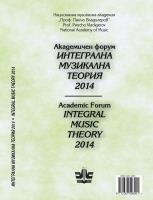
Методически и исторически аспект
The interaction between classical and modern harmony is seen from a methodological aspect as a systematic and structural category, namely as a tone system that more or less destroys tonality, and from a historical aspect – the time when that happened, namely at the end of the nineteenth century and approximately by the end of the mid-twentieth century. During that period, we can find out a number 75 of ‘border’ examples representing the opposite poles between the so-called classical and modern harmony, where tonality can be perceived in an atonal environment and vice versa – it can be an environment in a context beyond its borders in the works of composers as Brahms, Wagner, Wolf, Bruckner, Mahler, Reger, Strauss, Schönberg, Berg, Webern, Debussy, Bartok, Shostakovich. We can find such occurrences earlier by composers such as Mozart, Beethoven and Schubert. Such a process is technologically and structurally implemented mostly in chromaticism, which should be seen simultaneously, not separately, in the two types of harmony. Such an approach is suggested by the author as a new aspect in the teaching methods of the subject of Harmony in Bulgaria.
More...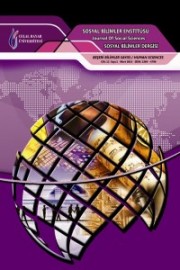
It is a known fact that the sacred names in Islam have been used in calligraphy and illumination art works of our culture throughout history, especially in our mosques which are the most important elements of our religious architecture. It has been a tradition since the Ottoman era to write the names of Allah and the prophet as well as four caliphs, Ali’s sons from Ehl- i Beyt (people of the house) on the walls of the mosques. On the other hand three mosques in the Menteşe distric of Muğla - Şahidi Mosque, Keyfoturağı Mosque and Çatakbağyaka Village Mosque- have symbols about the names of Ashab al-Kahf (Seven Sleepers) among the others. It is not common to have the names of Seven Sleepers written on the walls of mosques. In addition there is no clear information about the reason why they are included. Nevertheless, inclusion of Ashab al-Kahf in the sacred book Koran and its being a well known and accepted story among the residents of the region can be seen as the main reasons for using the names in these mosques. Likewise, the fact that Muğla was an important Mevlevi city in the past suggests that it may have a Mevlevi effect. As a result the sybomls of Ashab al-Kahf must have taken place in these mosques in order to take the community lessons for itself and to direct its life in accordance with the purpose of Koran and the Masnavi.
More...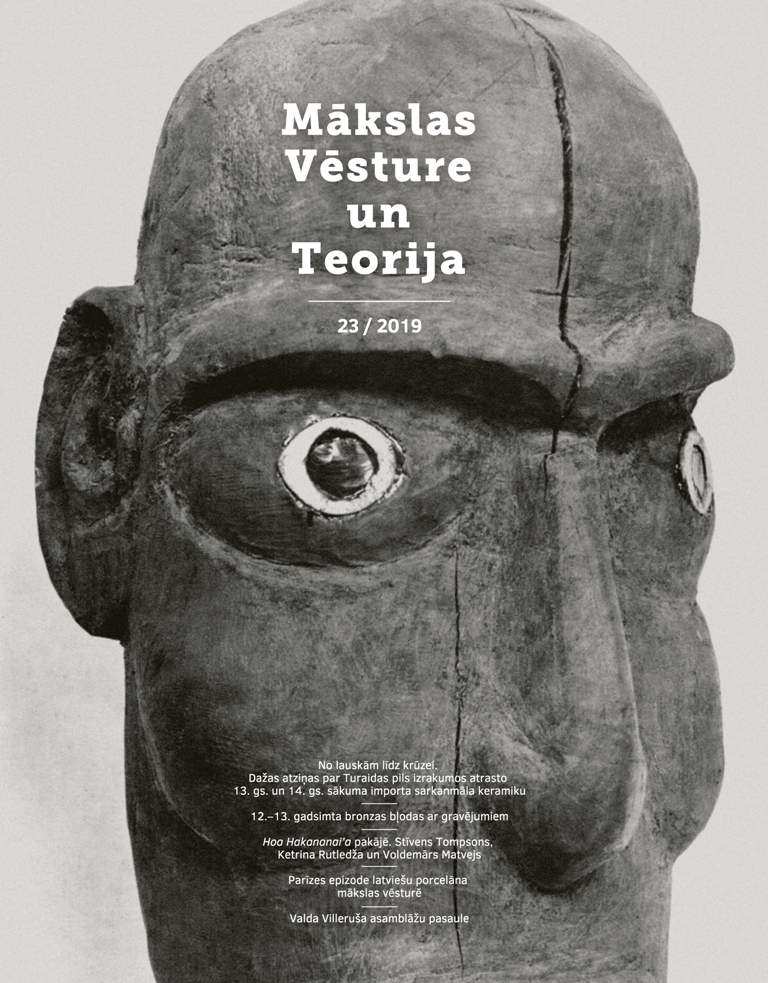
This year is the 100th anniversary of the publication of the book The Mystery of Easter Island: The Story of an Expedition by British traveler and ethnographer Katherine Routledge. However, the aim of this article is to draw attention to her contemporary, Latvian artist and theoretician Voldemārs Matvejs’ (1877–1914) study of Oceanic art Искусство острова Пасхи (The Art of Easter Island), published in Russian under the pseudonym of Vladimir Markov in St. Petersburg in January 1914 with a print run of 500 copies. Both publications feature one of the British Museum’s most popular exhibits – the photograph of Hoa Hakananai’a. Therefore, the author has gathered information on the British photographer Stephen Thompson (1831–1892) who created this image. The article also presents the first comparative analysis of both publications, emphasising common as well as different elements in both researchers’ activities, each having their own aims, interests and opportunities to familiarise themselves with the cultures of the world. Katherine Routledge graduated from the University of Oxford with honours in 1895, specialising in modern history. When the Second Boer War was over, Katherine went to South Africa as a member of a women’s committee in 1902. In 1906, aged forty, she married the ethnographer, anthropologist and traveller William Scoresby Routledge (1859–1939). In 1908 the couple arrived in the British protectorate in East Africa (now Kenya), settling on the territory of the largest ethnic group, the Kikuyu people. They later donated their collected ethnographic materials to the British Museum as well as to Pitt Rivers Museum in Oxford. They described their impressions in a jointly written book With a Prehistoric People. The Akikuyu of British East Africa (1910). Voldemārs Matvejs did not have the opportunity to visit the African continent in person and so made it his aim to inspect the ethnographic collections of Western European museums. From 24 July to 15 September 1913, together with a close associate, Varvara Bubnova (1886–1983), he visited Kristiania (now Oslo), Copenhagen, Hamburg, London, Paris, Cologne, Leiden, Amsterdam, Leipzig and Berlin. In the course of less than two months, he gathered rich material on African and Oceanic art as well as took photographs of certain objects. The artist’s notes have not come down to us, so there is no information on how the works were selected. Therefore, Matvejs’ original photographs of sculptural examples from Africa and other regions published in his books as well as the few pictures of individual exhibits taken by other photographers provide an insight into his research work. When analysing Matvejs’ photographic method, it is important to spot analogies and thus the author’s attention was drawn to the work of Stephen Thompson who took the photograph of Hoa Hakananai’a and photographed over 5000 museum exhibits from December 1869 to early 1872. The London publisher W. A. Mansell & Co issued the album British Museum Collections with his photographs. The catalogue represented Greco-Roman and medieval art while the last seventh volume dealt with the overseas territories of the British Empire. Thompson became the first photographer who had the opportunity to capture more than 150 ethnographic objects – artefacts and sculptures from the region of Polynesia as well as the masks of Peru Indians, Aztecs and other native American peoples. Thompson also photographed new acquisitions, including two stone figures Hoa Hakananai’a and Moai Kava donated by the Queen to the British Museum in 1869. The photographer probably took pictures of these moai in the period between 1869 and 1872. Especially significant is Thompson’s photographic documentation of Hoa Hakananai’a from behind, as he had the rare, exclusive opportunity to capture the forms, contours and finish of this monumental sculpture at eye level. Many later researchers did not have this opportunity, as Hoa Hakananai’a was often located in places and heights ill-suited for viewing and taking pictures. It was placed either too low and close to the wall in the colonnade outside the British Museum where Matvejs photographed both the aforementioned figures in summer 1913, or on a pedestal too high, thus not even allowing one to see important details from the correct distance and angle. Therefore, the value of Thompson’s photograph is understandable along with the reason why both the British ethnographer Routledge and Matvejs used it in their publications. Katherine Routledge acquired all the necessary information herself on Easter Island where she stayed for 17 months. Her experience was later described in detail in the weighty volume of 400 pages The Mystery of Easter Island: The Story of an Expedition with its 166 pages focusing on Easter Island. Routledge described the island’s landscape and flora, local people’s way of life, beliefs, religion, living conditions, eating and dressing customs, the family model, property relations, legends, the cult of the Bird and the dead, burial traditions, ancient names of the island as well as the origins of its language and writing. Routledge’s contribution to the description and photographic documentation of artworks, especially stone sculptures, is immense. Only 105 images from the huge photographic archive, now in the collection of the British Museum, were included in the book. Artist and theoretician Voldemārs Matvejs’ interest in world cultures is related to his searches for a new ideal of beauty typical of early 20th century modernist art. At the St. Petersburg Academy of Arts where Matvejs studied the basics of painting, the classical Greco-Roman ideal of beauty was still prevalent. However, the budding artist took up theoretical and research activities. Familiarising himself with sculptural examples “of all peoples and periods”, Matvejs came to realise that outside Europe, an artwork is not just an artwork, it could also fulfil certain social and ritual functions. To understand better the specificity of sculpture, its place and role in the spiritual organisation of society in the Pacific region and on Easter Island in particular, he carefully studied the notes of the few travellers and art collection catalogues of European museums. Especially useful were travel notes and eyewitness accounts of such visitors to Easter Island as the British Captain James Cook (1728–1779), French pastor and missionary Eugène Eyraud (1820–1868) and German seaman, Lieutenant Wilhelm Geiseler (1847/48–1891). The first chapter of Matvejs’ study also made use of the information from the album of wooden sculptures by the first Catholic Bishop of Tahiti, French missionary Étienne Florentin Jaussen (1815–1891), known also as Tepano; an essay on Easter Island published after the missionary’s death proved useful too. In the second chapter of his book that dealt with the art of Easter Island, Matvejs carried out artistic analysis, comparing stone and wooden sculptures, and he formulated 11 characteristics common to both groups and 4 that set them apart. The book’s textual part is complemented by only 22 black and white images of 5 stone and 11 wooden sculptures from the Oceanic region; the specificity of Easter Island is exemplified with photographs of only 2 stone and 7 wooden sculptures. However, even such scarce visual information reflects the artist’s attempts at establishing the specificity of regional sculpture. Matvejs hypothesised that the unifying element of both stone and wooden sculptures on Easter Island was the facial construction and its characteristic formal features. This was the reason why he took close-up photographs of wooden sculptures. According to Matvejs, Easter Island was the origin and centre of the traditions of Oceanic art, spreading its influence over the entire vast Pacific region. Therefore, he looked for analogies and photographed some 20 sculptural examples from Tahiti, Hawaii, New Guinea and the Marquesas Islands both from one angle and from several angles with the aim of confirming his theoretical assumptions. Matvejs looked for analogies not as an ethnographer but as an artist who focused not just on the characterisation of “another beauty” widespread there but also on similarities and differences in the continuation and interpretation of this tradition by a particular region or artist. He possibly took over his interest in characteristic details from the 19th century photographers. Nevertheless, Matvejs thought that it was important to single out the peculiarity of each region and so he varied the composition of the frame and often framed the original in line with his conception, emphasising the totality of formal means not typical of European art in the interpretation of the figure and especially its head. Each image has the additional task of serving as a negation of the European classical artistic tradition. Easter Island was for Matvejs “Classical Greece” in the Pacific. He considered the Easter Island sculptures to be of higher value than those of Classical Greece. Although there are obvious reasons why Stephen Thompson, Katherine Routledge and Voldemārs Matvejs never met during their lifetimes, each of them took part in a prolonged process of aesthetic education in their respective fields of expertise. Routledge left us outstanding examples of documentary photography, preserving a unique chance for the next generations to view the sculptures of Easter Island in their natural environment. Voldemārs Matvejs as an artist not only discerned the role of Easter Island and Oceanic art in the 20th century cultural context but also somewhat envisioned a more distant perspective of artistic development. The trend of Surrealism whose emergence he did not live to witness has recognised the art of Easter Island as one of its strongest sources of inspiration.
More...
The article informs about the international conference "The Migration of Artists and Architects in Central and Northern Europe. 1560-1900)" that took place at the Latvian Academy of Art and Rundāle Palace in 26-28 September 2019, briefly describing the issues tackled in the papers that were presented at the event.
More...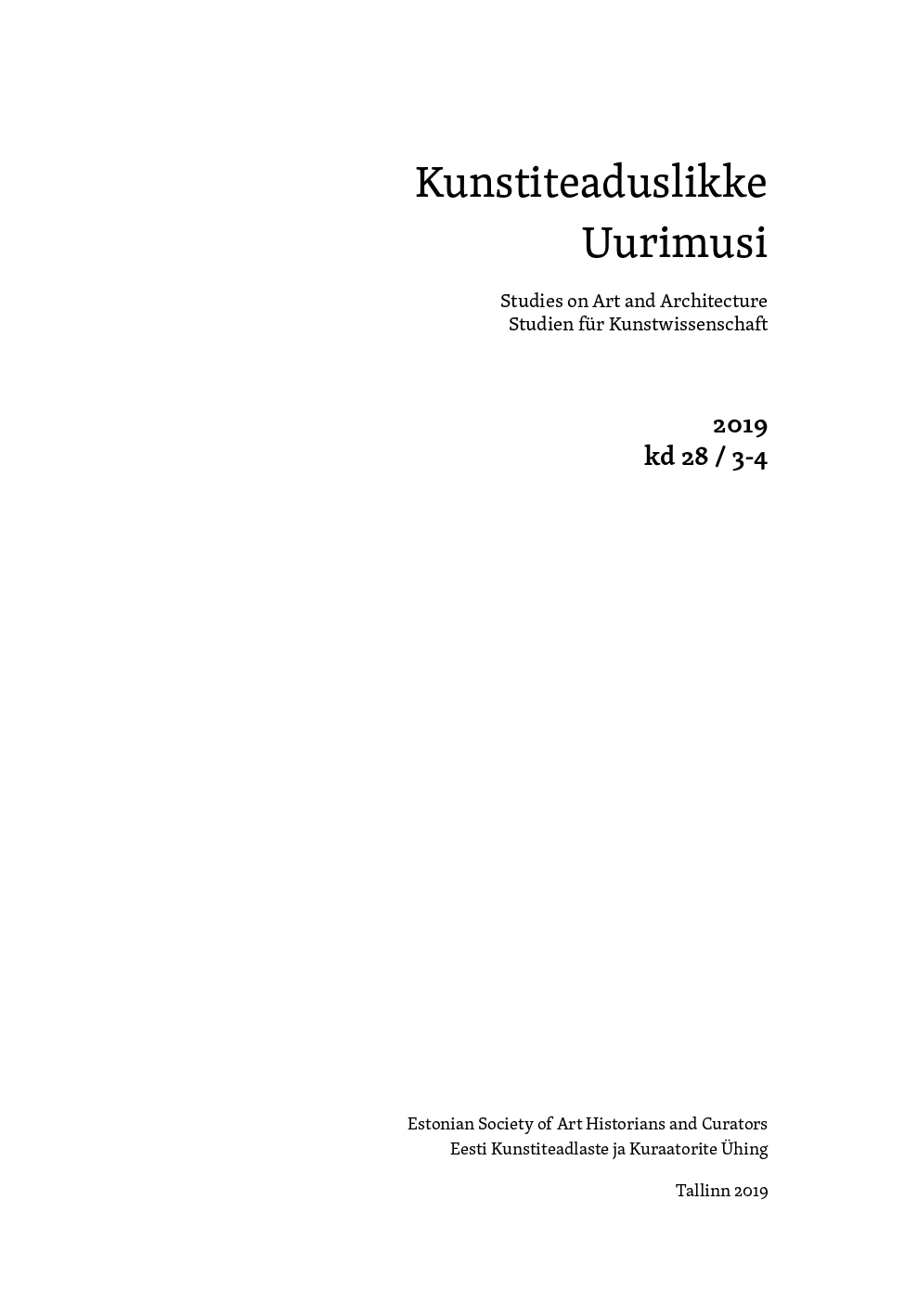
The focus of this article is Estonian decadent art of the early twentieth century, which manifests masculinised sexual violence. More specifically, violence against women presented from a male perspective, with the male subject as the perpetrator. The study seeks to fill a gap in the history of Estonian art, which omits the analysis of depictions of sexual violence, although visualisations of aggression and dark desires were common in the art of the time. These depictions of sexual violence were related to the processes taking place in the Estonian society, which were connected with both fixed and changing perceptions of sexuality. The topic analysis is done on the works of six male artists: Aleksander Promet, Eduard Wiiralt, Erik Obermann, Gori, Nikolai Triik and Voldemar Kangro-Pool.
More...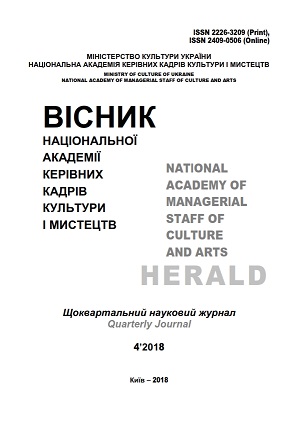
The purpose of the article is to study the Ukrainian chamber creativity of the late 20th – early 21st centuries from the point of view of analyzing the methods of paratextual programming of ensemble pieces for various types of thematic and meaningful representativeness and related processes of music inheritance of some artistic and expressive functions «transposed» from unrelated arts. Methodology. Used a set of methodological approaches of textological, semantic, synesthetic, cultural analysis. Scientific novelty. The study of paratextual programming of the compositions of the chamber art of Ukraine of the late XX – early XXI centuries allowed, on the one hand, to emphasize thematic areas of representation in music of artistic images (plots, themes, motifs) from works of other arts. On the other hand, it made it possible to detect the presence of interaction between different types of art not only at the semantic but also at the semiotic-expressive levels, which is implemented through the introduction of specific techniques of the semiotic «translation» of semantic and structural «cliches» of rhetorical, graphic, plastic, theatrical expression. Conclusions. Systematization of methods of paratextual programming of chamber art works in Ukraine in the late ХХ and early ХХІ centuries allows us to single out several groups of their thematic representativeness on the principle of interaction in musical-literary, -visual, - theatrical and -movie correlations. The intersemiotic semantic connection of the musical text with its paratextual component (reflected in names, auto-commentaries, remarks, epigraphs, dedications) is often emphasized in a semiotic and expressive manner. The study of this process reveals that at an semiotic level of comparison and identification of stylistic techniques (which initially have a non-musical species origin and a method of artistic and material embodiment) is carried out by means of technical and compositional operation with rich sound-visual resources of music. The potential of their disclosure (using intonation, microtonic, timbre, phonical, textural, polyphonic means, including «voiced silence») is aimed at obtaining a synesthetic perceptual effect that creates the illusion of semiotic conformity and a kind of «transfer» to the audible space of ensemble compositions of extra-musical artistic and expressive techniques and functions.
More...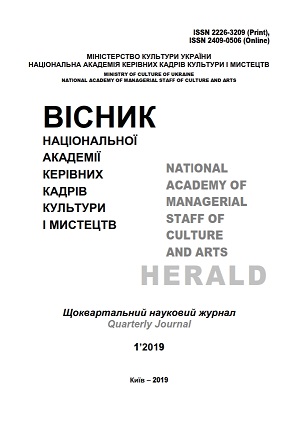
The purpose of the work is introduction term applied art studies into contemporary Ukrainian cultural discourse. The attempt to describe it‘s tasks is made. Methodology of the research consists in the applying methods of formal logic, namely analysis, synthesis, induction, deduction and systematic approach and generalization. Also used descriptive and historical comparative methods. Scientific novelty. Art history as a complex of three disciplines is analyzed and doubted for the first time. In the study stated the urgent need to revise the well-established understanding of art history and art criticism. Also states the need to formulate a new definition of this science. Conclusions. Research has shown that differentiation of science is necessary. Meaning of the term applied art studies is discussed. An attempt was made to describe its goals, objectives and components.
More...
The objective of this paper is caused by the actual problem of comprehension the Stefan Turchak creative style as a phenomenon of national cultural scale through the identification and comparison of the individual-style dominant and the typical national style determinants of the conductor's art. To achieve the goal the semantic field of the essential characteristics of the Ukrainian national character is considered, the scientific idea of the main intonational idea of the conductor's style is formed, the peculiarities of the individual- style approach of the performer, coherent with the Ukrainian national constants are analyzed on the example of the interpretation of the J. Brahms The First Symphony c-moll. The research method is combination of cultural and musicological methods which allows to form a coherent picture of Turchak's arts phenomenon. The scientific novelty of the work is in the deepening understanding of the interaction of individually stylistic and national-style factors in the formation of the phenomenon S. Turchak‘s conductor art and creating theoretical basis of his works style analysis. Conclusions. On the basis of the interpretation analysis of J. Brahms the First Symphony done by S. Turchak, the main intonation idea of his performing style, which described as the transforming reality of emotionalism, was conceptualized as the conclusion. According to S. Turchak the originality of the interpretation Brahms‘ style is defined as the individualstyle dominant of his art (subjective factor) and Ukrainian national-style determinants (objective factor). It is known that individual style and national style in music (and in the art as a whole) are the most genetically related. It can be argued that the nationally determined specificity of S. Turchak‘s worldview provides an honorable place to his original interpretative concepts in the process of forming the world music culture text of global scale which is still going on.
More...
The purpose of the article. The publication attempts to determine the iconography, the manner of carving and dating of the decorative art monuments from the wooden church decoration of the Central Ukraine in the first half of the XVIII century. Methodology. Within the framework of the article and on the basis of the art research studies, the main task is the introduction of the woodcarver art monument, i.e. the Holy doors from the iconostasis of the Church of the Descent of the Holy Spirit in the village Shkarivka, Bilotserkivskyi district, Kyiv region, into the scientific circulation. Scientific Novelty. In the study, the attention of the scientific community is focused on the art studies research of the newly discovered unique decorative art monument, which is likely to be in situ. The work proposed for publication is part of the research results on the development and modification of the decoration of wooden church architecture on the territory of Central Ukraine in the first half of the XVIII century. Conclusions. According to the results of the author's art studies of iconographic and stylistic features of the carving, the Holy doors of the iconostasis of the Church of the Holy Spirit's Descent in the village Shkarivka, in Bila Tserkva district, Kyiv region, we have grounds to include them in the artistic heritage of the first half of the first half of the XVIII century with possible later additions.
More...
Purpose of the article. The article aims to identify and analyze ethnic images as one of the main characteristic segments of the corpus of paintings by Ukrainian artist of Armenian origin Valeriy Geghamyan. The methodology consists of the use of historical, biographical, complex, comparative methods as the main elements of art criticism tools. The scientific novelty of the work lies in the fact that the author makes a first attempt in the domestic science of art to cover individual pages of life and work of V. Geghamyan, having analyzed the ethnic images to which the artist turned throughout almost the entire creative path, to highlight the style-forming factors that took place in the formation of this imagery. Conclusions. Among the main ethnic images of the artist are Armenian and Ukrainian, less – Russian, which corresponds to the main periods of creative work of V. Geghamyan – Armenian, Russian and Ukrainian (the latest, the longest). Occasionally, the master turned to the images of the Kurds, African, Spanish types, but the dominant throughout the creative path were the colorful characters of those who personified the historical homeland of the artist (Armenians), and those who personified his second homeland, Ukraine, where he settled since the 1960s.
More...
The purpose of the article is to trace on the historical facts how Kyiv opera school developed during the second half of the twentieth century and which role in this process was played by the Opera Studio because this period is characterized an active evolution of it despite the Soviet engagement. The methodology of the research is to apply analytical, historical and art-study research methods for determining the ways of development of Kyiv opera school of the specified period. The research is based on the practical experience of specialists in the field of musical and theatrical art. The scientific novelty of the research is to analyze the methods of disseminating on the educational process of the NMAU named after P. I. Tchaikovsky the acquired traditions and experience of many generations of leading opera singers who formed the national vocal-performing school. Conclusions. As a result of the research, it was found that the history of the functioning of the department of solo singing of the Academy testifies to the tradition of attracting to the teaching work, as a rule, the most talented and experienced singers-actors who in their creative heritage have at least 25-30 years of work on a professional opera stage and get performing experience (through studying, internship or touring in Italy, France, Germany, etc.), gained recognition at the state and beyond and have become indisputable carriers of their teachers' schools. This conclusion applies both to the founders of the department and the subsequent generations of teachers.
More...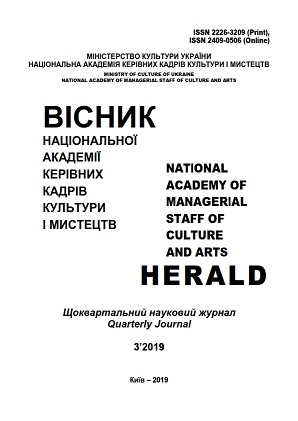
The purpose of the article is to identify the poetic-intonational uniqueness of the P. Hindemith‘s cycle ―The Life of Mary‖ in the context of the religious and aesthetic attitudes of the composer‘s work and the spiritual and stylistic specificity of German culture of the first half of the 20th century. The methodology of the work is based on the cultural-historical approach in musicology; inherited from B. Asafiev and his followers, as well as on interdisciplinary, etymological and historical-culturological approaches. The scientific novelty of the work is determined by the fact that the mentioned cycle of P. Hindemith is first considered in Ukrainian musicology and art history from the perspective of not only the spiritual and creative position of the composer but also the evolutionary paths of the vocal cycle in the German cultural, historical and musical traditions of the XIX-XX centuries. Conclusions. For P. Hindemith, the emergence of the «Life of Mary» cycle is connected not only with the transition to neoclassicism positions, but also with an interest in the specifics of the so-called «new spirituality» or «new religiosity» essential for the culture of the entire twentieth century. For the cycle, genre synthesis is indicative, bringing it closer to mono-opera and the German spiritual cantata. This cycle is also characterized by equality of vocal and instrumental parts as components of a single polyphonic whole at the level of «contrapuntal unity». Polyphonism as defining the texture-style quality of the «Life of Mary» cycle is manifested in the extensive use of basso ostinato, fugato, canons, and methods of contrasting polyphony, which demonstrate the dominance of the linear principle and determine the neoclassical style of this work. The latter is also revealed through the rhetorical-semantic aspects of the Baroque forms and the symbolic-allegorical interpretation of tonalities.
More...
The aim of the article is to specify the symbolism of Monsalvat and Valhalla in the chronotop-sacra of the opera myth by R. Wagner ―Lohengrin‖. Research methodology is based on the principles of the mythology opera studies, music onomatology (the study of the mythologized toponymy); intromythological, encyclopaedic (the consideration of a ―new myth‖ as a romantic docta stilo), functional and typological, mythological and symbolic types of analysis. Scientific novelty. An attempt is made at revealing the characteristic aspects of functioning of the mythologized oronyms in the chronotop-sacra. Instead of the mythologized oronym Valhalla in Ortrud‘s ―prayer‖, the proper names of the former rulers of the German-Scandinavian world are introduced, which contain a hidden plot of the sacred mountain of the old world. Valhalla and Monsalvat had similar functions in different historical epochs (the world mountain of resurrection, a castle with a sacred hall, a lodging of celestial warriors of light), providing them the meaning of semantic twins. Christianization has caused the displacement of pagan mythology outside the sacral chronotop: in one mythological picture of the world there is no place for two sacred objects whose functions coincide. Valhalla, having taken an underground locus, turns into the rival of Monsalvat. The opera transmythology of ―Lohengrin‖ is based on the unification of mythologized stories of Valhalla and Monsalvat in the plot unity. Their confrontation is considered as the battle of Wunder and Zauber, an important role in the development of which has a mythologeme-image of the enchanted knight. The introduction of the name of Parsifal contributes to the addition of plot analogies with Klingsor – the castle-mountain, the embodiment of Zauber, another rival of Monsalvat from the last Wagner‘s opera. The time of the development of the action of ―Lohengrin‖ is considered as the day of the destroyed Klingsor. Conclusions. The theme of the confrontation between light and darkness often translates into the mythologeme ―magic mountain‖ through the composer‘s usage. The symbolism of Monsalvat and Valhalla in the musical drama is identified through the usage of mythology opera studies as an art based on the synthesis of the basic principles of mythology and opera studies, the application of the fundamentals of musical onomatology, common in both areas of mythologized onomastics: anthropo- and toponymy. Through the symbolism of the explicit (Monsalvat) and implicit oronyms (Valhalla and its analogues – Venus the mountain, Klingsor) in the mythologized toponymy operaasmyth there is an elucidation of the insight of confrontation between light and darkness, Christianity and paganism. The drama of the opera is interpreted as a duel of Monsalvat and Valhalla for dominating over the Brabant (Midgard) and Asgard.
More...
The purpose – to examine the stamps of the Kiev-Mezhigirsk Faience Factory for the chronology for the use of refined data in contemporary art criticism. The research methodology is based on historical-chronological, historical-cultural, cognitive approaches and method of art criticism analysis, which allow us to outline the specifics of the production of products of the Kiev-Mezhigirsk Faience Factory and comprehend the meaning of applying labeling. The scientific novelty consists in the introduction of verified information on authentic stamps and fakes in scientific treatment, including museum, in expert art practice, and the identification of falsification in the antiques market. Conclusions. Trademarks of Kiev-Mezhigirsk Faience Factory with the attribution of products should be divided into three stages of its historical activity: 1801 (the beginning of production for sale) – 1822 (the time of submission to the Kyiv magistrate), 1822 – 1858 – the personal property of the monarch in St. Petersburg and the management of his Cabinet [ministers], 1858–1874 – the period of tenants and sub-tenants: О. О. Shishkov (1856 – 1866); N. O. and V. O. Barskikh (1858 – 1865); M. V. Govorov (1870/1871 – 1874/1876 – the last year, when the furnace was working and it was possible to produce forms of finished products).
More...
Purpose of the article is to understand the main vectors of the development of portrait sculpture of Lviv, to investigate modernist searches in sculptural portraits of nonconformist artists of Lviv: Ya. Motyka, R.Petruk, P,Kulyk, I.Mykytiuk, V. Yarych. Methodology. The methodological basis for the work is the principles of historicism and a systematic approach to the objective coverage of the latest artistic phenomena on the basis of the study of a wide range of discovered theoretical sources. The mentioned principles directed scientific work on the complex application of general scientific and special art-study methods: art analysis, fenomenology, hermeneutics. Scientific novelty. Artistic analysis of stylistic features of the portrait sculpture of Lviv at the end of the twentieth century in the context of the ideas of non-conformism was conducted. In the studies of art critics, creativity of non-conformist artists is presented in general terms, that‘s why the object of research in the article is the portrait sculpture of Lviv at the end of the twentieth century. Changes that were made in the sculptural plastic of the marked period, an analysis of a number of sources related to the peculiarities of artistic and critical comprehension of complex creative processes typical for of Lviv portrait sculpture was carried out in this article for the first time. Conclusion. Starting from the second half of the 80s and during the 90s, in the context of independent Ukraine complex processes associated with the rapid decline of systems of information blockade and ideological control, the return to the lost achievements of modernism and attempts to adapt the philosophical approaches of postmodernism are taking place in the art. The 90s of the last century are marked by significant changes that tооk place in all areas of artistic creation. They also affected the genre of a portrait, in particular, a sculptural one. The retained for decades desire for a bold search and experiment captures not only former nonconformists but also younger artists who were formed on their experience. Some authors of older generations are boldly involved in the process. Their works, including portrait compositions, sometimes only remind remotely of specific figures and contain unique features of the portrait. The main emphasis is placed on the creation of a wide range of associations, where each spectator can choose his own way of perceiving an artistic work. Along with purely formal solutions in line with the realistic trend, the world-famous grotesque hyper realistic approach to the creation of a sculptural portrait is distinguished. However, the greatest manifestations of innovation can be found in the works of the artists who began to experiment on the brink of modernism and postmodernism, using new, still unknown yet expressive means and non-traditional materials.
More...
The purpose of the article is to outline aware and persistent efforts of K. Stetsenko in the areas of creative, pedagogical and social work for the national-patriotic education of youth, as well as the Ukrainian society as a whole. The methodology of the research lies in application of historical, biographical and system-analytical methods. The scientific novelty of the research is in the discourse of cultural and educational basis of Kyrylo Stetsenko‘s musical creativity, his pedagogical and social activities; in systematizing materials about his achievements as a composer, conductor, critic, teacher and public figure motivated by his national and patriotic priorities. K. Stetsenko inherited his love for art, folklore, and respect for Ukrainian sacral traditions from his parents‘ home. During his studies at the theological educational institutions and in M. Lysenko‘s Music and Drama School the grounds of his national self-awareness were set. This was also facilitated by his personal acquaintance with Mykola Lysenko. K. Stetsenko‘s managerial and choral activities, foundation of music publishing house, his work as a music critic and educator were motivated by his devoted commitment to the Ukrainian idea. The composer‘s patriotic attitude was reflected in his selection of freedom-loving poetry for vocal music, in composing a number of spiritual pieces, in interpretation of folk-verse and paraliturgical samples, in children‘s art. Conclusions. Due to his tireless social work, talent of a composer, pedagogical and managerial skills, the artist responded to the needs of the Ukrainian society and school, realized the demand for artistic-concert and didactic material, understood its significance for musical education and upbringing. Both musical and theoretical works of K. Stetsenko were based on national patriotic principles, and therefore they remain relevant to this day.
More...
Purpose of the article is to analyze the aesthetic canon of socialist realism and the principles of D. Lukacs and M. Lifshits in the projection on ballet criticism of the mid-30s. XX century (on the example of the ballet «Bright Stream» by Shostakovich-Lopuhov, 1936). Methodology. The use of methods for analyzing sources, concepts, comparing critical assessment approaches to the consideration of the ballet «Bright Stream» ensured an objective study. Scientific novelty. For the first time, the aesthetic principles of Lukach-Lifshic and the socialist-realist canon were extrapolated to the plane of ballet criticism of the mid-30s. XX century (on the example of the ballet «Bright Stream» by Shostakovich-Lopuhov, 1936). Conclusions. The requirements for observing the principles of socialist realism in art, the main of which were partisanship and nationality, were transmitted through critical articles. Opposing the simplified understanding of realism and its reduction to established stylistic canons, the founders of the journal «Literary critic» (Moscow, 1933–1940) D. Lukach, M. Lifshic, and others defended extra list criticism, since the artistic value of a work cannot be revealed exclusively through a prism style; substantiated the realism of art through proof of the reality of the content of any work of art; introduced the principles of friendly discussion and deep mutual respect of the critic and creator. The article «Ballet Falsehood» (February 6, 1936, criticism of the Shostakovich-Lopuhov ballet «Bright Stream» at the Bolshoi Theater, Moscow) played the role of a translator of the aesthetic requirements of the authorities for the art of ballet, a model of propaganda of mono-ideology through criticism. The article became a kind of warning to critics about the consequences of positive evaluations of ballets without correlating them with the canon of socialist realism.
More...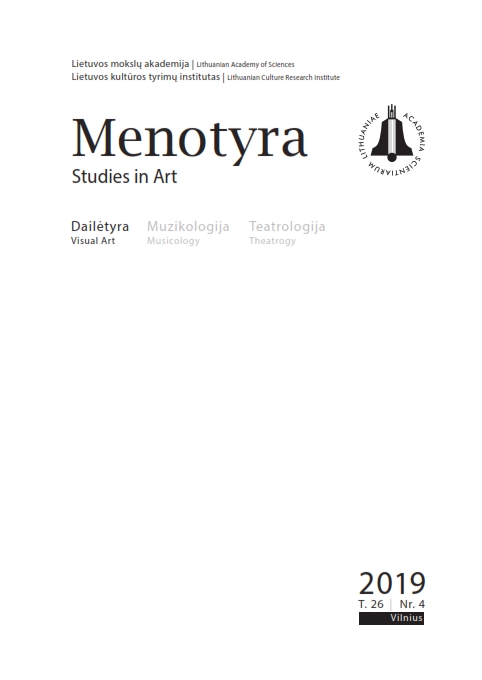
The article presents Lev Alperovich, a little-known to general public Belarusian painter of the beginning of the 20th century, who was Ivan Trutnev’s student in Vilnius Drawing School and a student of Ilya Repin in the Emperor’s Arts Academy in St. Petersburg. The works of Lev Alperovich that survived after the World War II are kept in the National Art Museum of the Republic of Belarus. The analysis of the painter’s biography and creative heritage reveals a new vector which was gradually emerging in Minsk at the beginning of the 20th century, i.e remoteness from the academic late “peredvizhniki” realism and the ambition to find a niche in the evolving Russian modern style or the European Art Nouveau style and symbolism. Relatively sparse artistic heritage of Alperovich – single and group portraits, genrepainting, every-day life scenes and staffage landscapes – allows the author to single out this painter as a Belarusian painting phenomenon of the 20th century.
More...